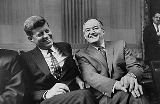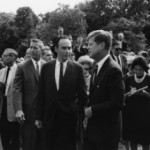Because of John F. Kennedy We Are The Peace Corps

Remarks of Senator John F. Kennedy
At 2:00 a.m. on October 14, 1960, Senator John F. Kennedy addressed students on the steps of the University of Michigan Union. In his speech, he challenged the students to give two years of their lives to help people in countries of the developing world. The following is an excerpt of his short address to the students that night.
I come here tonight delighted to have the opportunity to say one or two words about this campaign that is coming into the last three weeks…
How many of you who are going to be doctors, are willing to spend your days in Ghana? Technicians or engineers, how many of you are willing to work in the Foreign Service and spend your lives traveling around the world? On your willingness to do that, not merely to serve one year or two years in the service, but on your willingness to contribute part of your life to this country, I think will depend the answer whether a free society can compete. I think it can! And I think Americans are willing to contribute. But the effort must be far greater than we have ever made in the past.
 Kennedy was not the first person to try to create a Peace Corps. The first person to introduce a bill creating an organization like it was Senator Hubert Humphrey in 1957. Sadly, it didn’t pass.
Kennedy was not the first person to try to create a Peace Corps. The first person to introduce a bill creating an organization like it was Senator Hubert Humphrey in 1957. Sadly, it didn’t pass.
In June 1960, Humphrey would again recommend to the Senate “the formation of such a corp now, rather than waiting for a study.”
The idea was in the air.
In 1958 William Lederer and Eugene Burdick would publish a novel, The Ugly American, that did, in the words of Elizabeth Cobbs Hoffman “wove together anxiety over the national character with the perception that America could no longer communicate with less privileged peoples and was thus losing the cold war.”
The Ugly American, a Book-of-the-Month Club selection that went through fifty-five printings in two years, became a direct motivation for the Peace Corps. Kennedy sent a copy to every member of the Senate in January 1959. Nearly every early staff member of the Peace Corps Elizabeth Cobbs Hoffman writes in her 1998 book, All You Need Is Love: The Peace Corps and the Spirit of the 1960s, told her that the book was an inspiration for them.
The Ugly American portrays an America that could save itself, and in the process save the world, by rediscovering its frontier character under frontier conditions.
Three years later, during his 1960 presidential campaign, Kennedy mentioned the idea one more time–Americans challenging the world, of doing good for others–at 2 a.m. in the morning at his University of Michigan speech to students who had stayed up all night to greet the candidate. The date and time of JFK’s address is now considered the creation of the Peace Corps. (One small note, I was there that night covering the event for the radio I worked for in Kalamazoo, where I was also a graduate student at WMU, and while interviewing students I learned that the ‘girls in the dorms’ were for the first time allowed to stay out later than 10 p.m. The Dorm Mothers had bent the rules so they could see Kennedy. How times have changed on college campuses.)
While Kennedy was challenging the “girls and boys” at Michigan, others nations around the world were feeling the same urge to improve the lives of the peoples of our planet.
Between 1958 and 1965, nearly every industrialized nation started volunteer programs to spread the message of economic development and international goodwill. The idea of a ‘peace corps’ was sweeping across the world. Young people everything were telling their leaders and Kennedy to seize this moment.
In September of that year, Lyndon Johnson, Kennedy’s running mate, spurred on by a kid who worked for him–Bill Moyers–also called for a “‘volunteers for peace’ program that would offer our young people an opportunity to serve humanity in the remote stretches of the world.”
When JFK left the steps of the Michigan Student Union in the early morning of October 14, 1960, to grab a few hours of sleep before his next day of campaigning he remarked to one of his aide that he had ‘hit a winning number.’
The Peace Corps idea was the only new proposal to emerge from the Nixon/Kennedy 1960 presidential race.
But how did it happen?
It happened this way.
On that cold morning in October two Michigan graduate students, a married couple, responded to Kennedy’s challenge and not only picked up the flag but rallied undergraduates and graduate students to the idea, first at Michigan University, then across the state, across the Mid-West, and finally across the country.
Let us not–50 + years later–forget those two kids, those graduate students, who ‘seized the

Ethiopian CD Harris Wofford & JFK Greeting First PCV to Ethiopia, August 1962
moment.’ As Harris Wofford points out in his book, Of Kennedys And Kings: “It had been an era in which few young people had been politically active, and in which graduate students particularly were known for their political apathy.”
Not Alan and Judy Guskin.
Alan and Judy Guskin (who later were PCVs in Thailand) wrote a letter to the editor of the Michigan Daily, and another student, Tom Hayden, who later was the leader of Students for a Democratic Society, and later still one of Jane Fonda’s husbands), who was editor of the school’s paper, published the letter and reported on what the Guskins and others were doing. Hayden would win a journalism award for its imaginative coverage and support of the Peace Corps movement.
The Guskins’ letter asked students to join in support of Kennedy’s idea of service and very soon they were holding meetings for students and faculty members and organizing themselves into a group called “Americans Committed to World Responsibility.”
The Michigan students also asked Nixon to purpose something like a ‘peace corps’ and Republican Jacob Javis of New York urged Nixon to take up the plan. Nixon said no, calling such a movement ‘draft dodging.’
Then, 14 days before the election, at the Cow Palace in San Francisco, in his last major speech of the campaign, Kennedy spoke of creating a “Peace Corps” when he began president. He used the term “Peace Corps” for the first time.
What Kennedy did–and what no other world leader had done–was to incorporate volunteering into its foreign policy of the country in an attempt to demonstrate one alternative to power politics. The sheer size of the Peace Corps distinguished it, pointing to what may be an American characteristic worthy of note, writes Elizabeth Cobbs Hoffman, “the preference for bigness, the impulse to create programs on a large scale in order to demonstrate that the activity they represent is important.”
Hoffman goes onto write in her book, “The Peace Corps illuminates the Kennedy popularity that continues to mystify historians who knew the shortcomings of the man in office so briefly. At the same time we should remember when evaluating the Peace Corps that Kennedy did not create it alone. It grew out of popular demand.”
It grew out of the work and organization of Al and Judy Guskin who first rallied and organized the students of America to the idea. It was a ’60s idea that each decade since has kept alive, and each new generation renewed by asking themselves: what can I do for America?
We are the Peace Corps, the shiny creation Kennedy proposed in the last days of the 1960 presidential campaign, his experiment in international development that others called a wacky and dangerous idea. The Daughters of the American Revolution warned of a “yearly drain” of “brains and brawn..for the benefit of backward, underdeveloped countries.” Former President Eisenhower declared it a “juvenile experiment,” and Richard Nixon said it was another form of “draft evasion.” The following year, in 1963, Time magazine noted in a cover story that the Peace Corps was “the greatest single success the Kennedy administration had produced.” The Peace Corps is still Kennedy’s greatest achievement.
We Are The Peace Corps. We Are Its Volunteers. And we still are, 50th years after Kennedy’s death.
Good piece, John
Tom
“…contribute part of your life to this country,” I never thought of my Peace Corps service, years in the Foreign Service or years in international business as contributing to my country but as laboring in the vineyards of the “global economy.” Yes, I read “The Ugly American” at age 17 and decided to work to improve the image of America abroad but more importantly, I could see an economy that incorporated all the world into one great enterprise. And I am convinced that this global economy” is the best thing to happen to my country as well as the rest of the nations.